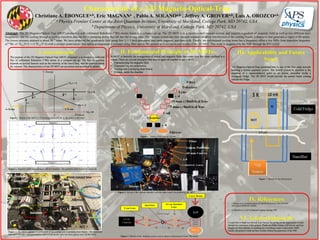Recommended
More Related Content
What's hot
What's hot (20)
Effect of a_high_opacity_on_the_light_curves_of_radioactively_powered_transie...

Effect of a_high_opacity_on_the_light_curves_of_radioactively_powered_transie...
Nanoscience MPhys Final Year Research Project Poster Presentation

Nanoscience MPhys Final Year Research Project Poster Presentation
Cathodoluminescence for Gallium Nitride Semiconductor Materials

Cathodoluminescence for Gallium Nitride Semiconductor Materials
Prospects for Electron-Ion-Circuit Hybrid Quantum Systems_AltoOsada

Prospects for Electron-Ion-Circuit Hybrid Quantum Systems_AltoOsada
Similar to APS meeting
http://www.ijeijournal.com/pages/v2i5.htmlStudy of Optical Character of Nano-antenna

Study of Optical Character of Nano-antennaInternational Journal of Engineering Inventions www.ijeijournal.com
Similar to APS meeting (20)
A New Theoretical Approach to LENR Usint the BSM-SG Atomic Models.

A New Theoretical Approach to LENR Usint the BSM-SG Atomic Models.
Module PHY6002 Inorganic Semiconductor Nanostructures Lectur.docx

Module PHY6002 Inorganic Semiconductor Nanostructures Lectur.docx
Optical Fiber Device For Coupling A Composite-Type Optical Fiber Scope And Pu...

Optical Fiber Device For Coupling A Composite-Type Optical Fiber Scope And Pu...
Maidana - Modification of particle accelerators for cargo inspection applicat...

Maidana - Modification of particle accelerators for cargo inspection applicat...
Physical Models of LENR Processes Using the BSM-SG Atomic Models

Physical Models of LENR Processes Using the BSM-SG Atomic Models
1988 a study of the thermal switching behavior in gd tbfe magneto‐optic films...

1988 a study of the thermal switching behavior in gd tbfe magneto‐optic films...
APS meeting
- 1. Characteristic of a 2-D Magneto-Optical-Trap Christiane A. EBONGUEa,b, Eric MAGNANa , Pablo A. SOLANOa,b , Jeffrey A. GROVERa,b, Luis A. OROZCOa,b a Physics Frontier Center at the Joint Quantum Institute, University of Maryland, College Park, MD 20742, USA b Department of Physics, University of Maryland, College Park, MD 20742, USA Abstract: The 2D Magneto-Optical-Trap (MOT) produces a cold collimated Rubidium (87Rb) atomic beam in a compact set up. The 2D MOT is in a stainless steel vacuum system, and requires a gradient of magnetic field as well as two different laser frequencies, one for cooling through a cycling transition and one for re-pumping atoms that fall into the wrong state. The vacuum system has four vacuum windows to allow retroflection of the cooling beams, a dispenser that generates a vapor of Rb atoms. The lowest pressure attained is about 10-10 mbar. We have produced the quadrupole field using first ½ × 3 inch permanent rare earth magnets, and then coils. Finally, the red-detuned cooling beam has a frequency offset a few MHz from transition frequency of 87Rb, (5 2S1/2 F=2 → 5 2P3/2 F=3) with a circular polarization. The optics arrangement is compact using fiber optics. We present here advances and results of the 2D MOT. This work is supported by the NSF through the PFC@JQI. I. Introduction: The purpose of the 2D Magneto-Optical-Trap (MOT) presented is to produce a sufficient flux of collimated Rubidium (87Rb) atoms in a compact set up. The flux in question depends on several features such as the intensity of the lasers used, and the pressure inside the vacuum. The characteristics of our 2D MOT are presented and described in details. Figure 3: The MOT requires a combination of the cooling and re-pumping laser beams. The combined laser goes through a tapered amplifier and it is eventually split into three beams used for the MOT. Figure 4: Set up of the vacuum chamber with the optics used for producing the MOT II. Fundamental Principle of 2D MOTs: A MOT1 is basically the arrangement of optical and magnetic fields that create slow Rb atoms confined in a region. There are several principles that need to agree all together to get a MOT: • Characterizing the magnetic field • Characterizing the polarization • Cooling and re-pumping laser beams • Pressure inside the chamber Figure 1: Sketch of the MOT in 1D showing atoms driven to the center of the trap2. Figure 2: Magnetic fields measurement with two magnets. The gradient of the field is in Gauss/cm. IV. References: 1. J. Schoser et al., An Intense Source of Cold Rb Atoms from a Pure 2D-MOT. arXiv:physics/0201034v1 (2008). 2. H. Metcalf et al., Laser Cooling and Trapping. Springer 1999 VI. Acknowledgement: I would like to thank my advisor, Luis Orozco, for giving me the opportunity to learn through the realization of this project. Thank you Pablo Solano, Jeff Grover, and Eric Magnan for their patience in teaching me everything I need to learn about AMO. Finally, this project would not have existed without the generosity of the NSF. III. Applicability and Future Steps: The Magneto-Optical-Trap presented here is one of the first steps towards building a hybrid quantum system. The hybrid system in question is the coupling of a superconductor qubit to an atomic ensemble inside a cryogenic fridge. The 2D MOT would provide the atomic beam coming outside the fridge. Figure 7: Sketch of the final project Figure 6: Sketch of the imaging system used to observe fluorescence from 87Rb atoms Figure 4: Sketch of the Optical System
